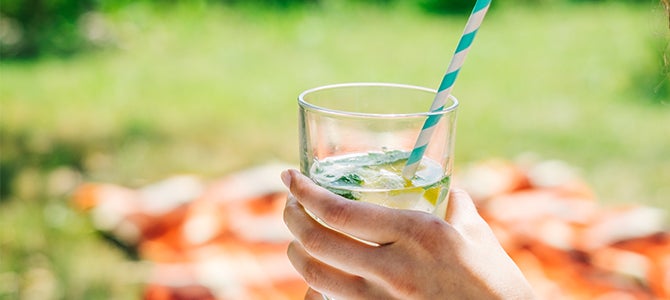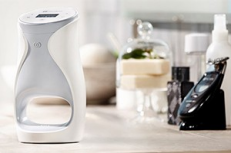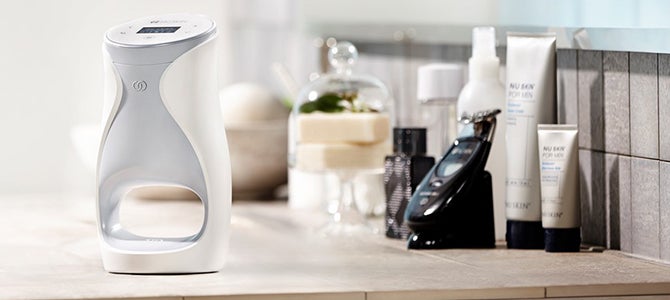The Importance of Hydration for Healthy Skin
August 03, 2016

Over half—approximately 60 percent—of the human body is comprised of water. There’s no doubt that water is essential to our survival. In fact, our bodies’ biochemical and cellular processes require water to function. Did you know that our organs hold different amounts of water? For example, blood, which carries oxygen and nutrients all over the body, is approximately 92 percent water, while the kidneys are 79 percent water and bones are 31 percent water1. Water also works differently in various organs, sometimes acting as a carrier of nutrients, a medium for eliminating toxins, a structural support, as well as a thermal regulator.
Water is also a key component of the skin. As the largest organ, the skin contains approximately 64 percent water1. Our skin has several different functions: to protect, regulate, and feel. It is a barrier against external toxins, like pathogens and chemicals. The skin also regulates body temperature and helps us sense our surroundings. As the outermost barrier of our body, skin regulates the body water content by controlling transepidermal water loss (passing from inside the body to the outside via the skin’s top most layer), as well as by blocking water permeation from the outside. Skin that lacks sufficient water supply can be dry, tight, itchy, and flaky. It may also look and feel rough and lack visible radiance. Dry skin will lose its soft, pliable characteristics and may crack, which could lead to the increased risk of infections2. Dehydrated skin may also have an increased risk of developing visible wrinkles3.
Factors Supporting Skin Hydration
Skin stays hydrated through a variety of methods. The stratum corneum (the outermost layer of the skin) prevents water loss through its structure of tightly organized lipid molecules7. It also contains natural hygroscopic (water-loving) molecules, like natural moisturizing factors, which absorb water from the environment.
Lycosaminoglycans, or “GAGs,” also promote skin hydration. GAGs help maintain and support skin proteins, like collagen and elastin. GAGs have tremendous water-attracting properties, which can help distribute water and water soluble molecules in the dermis4 and play a role in the turgidity of skin (i.e. ability to “bounce” back). Hyaluronic acid is a commonly used GAG in skin products due to its moisture-binding property.
Potential Causes of Dehydrated Skin
Research has shown that 40–72 percent of consumers have dry skin seasonally and/or on their face5. Skin can become dehydrated in two different ways: insufficient water intake and excessive water loss. While drinking water is obviously an important part of healthy skin, it may not be a sufficient solution to combat skin dehydration. An inadequate skin barrier will increase transepidermal water loss (TEWL), where water passes through the skin into the air. This is an invisible and unnoticeable phenomenon that differs from sweat, which can be seen and felt. TEWL can be measured and is an indicator of the skin’s barrier function6. For example, someone with atopic dermatitis, a skin disease characterized by deficiencies in the skin barrier function, would have higher TEWL than someone with healthy skin.
Moisturizing Daily for Soft, Supple Skin
Skin professionals recommend using a moisturizer daily. Moisturizers should include ingredients in one of three different classes to help promote skin hydration: 1) humectant, 2) emollients, and 3) occlusive.
Humectants are ingredients that bind water to the stratum corneum (the outermost layer of the skin). These ingredients draw moisture from the environment, but also carry it from the deeper layers of the skin to the surface. Sodium PCA, butylene glycol, glycerin, and hyaluronic acid are all examples of humectants.
Emollients provide skin with a soft, pliable feel. This class of ingredients remains on the skin’s surface, lubricating, reducing flakiness, and improving the overall appearance. Examples of emollients include lipids and oils. Shea butter, algae extract, and phosphatidylcholine are examples of emollients.
Occlusive ingredients help hold water in the skin by slowing down evaporation. Similar to emollients, these products remain on the surface, creating a thin film that helps block the loss of water. While historically this was thought to cause comedones—whiteheads and blackheads—these ingredients do not necessarily clog pores or create issues for the skin. Silicones, like dimethicone and cyclomethicone, are commonly used occlusives in personal care products. These ingredients work together to restore the balance between TEWL and skin hydration.
Selecting products that contain a combination of humectants, emollients, and occlusive ingredients can help maintain the needed moisture for healthy, youthful-looking skin. Below are some great options to help keep your skin hydrated:
Sources
1. The water in you. (n.d.). Retrieved July 06, 2016, from http://water.usgs.gov/edu/propertyyou.html.
2. Dry skin. (n.d.). Retrieved July 06, 2016, from https://www.aad.org/public/diseases/dry-sweaty-skin/dry-skin
3. The Benefits of Drinking Water for Your Skin. (n.d.). Retrieved July 06, 2016, from http://www.uwhealth.org/madison-plastic-surgery/the-benefits-of-drinking-water-for-your-skin/26334.
4. N. Dayan. Skin Aging Handbook. Norwich, NY 2008
5. R. Voegeli, A. V. Rawlings, P. Seroul, and B. Summers. A novel continuous colour mapping approach for visualization of facial hydration and transepidermal water loss for four ethnic groups. International Journal of Cosmetic Science, 2015, 37, 595-605.
6. P.T. Pugliese. Physiology of the Skin II. Carol Stream, IL 2006
7. J. A. Bouwstra and G. S. Gooris. The lipid organization in human stratum corneum and model systems. The Open Dermatology Journal, 2010, 4, 10-13


